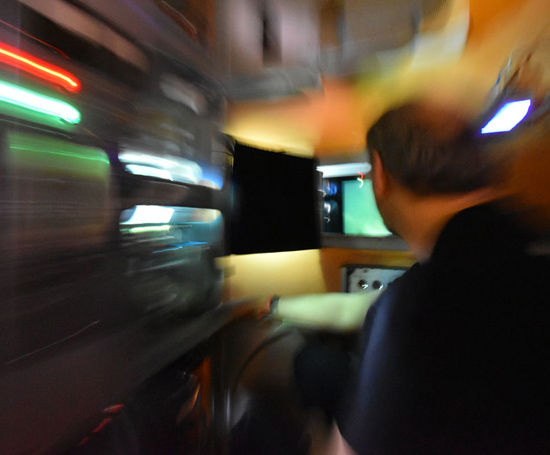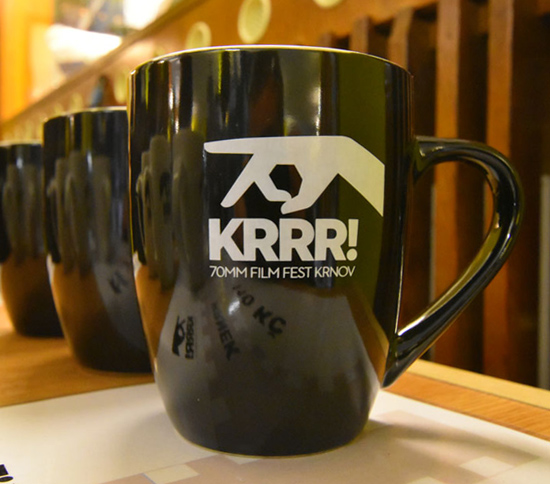The hidden festival, you should never miss |
Read more at in70mm.com The 70mm Newsletter |
| Written by: Aleksas Gilaitis | Date: 16.11.2018 |
 In the times when more and more of our beloved
cinema is becoming digital, analog film screenings are becoming the subject
of film preservation in itself. Since analog film has so many forms and
variations, some of the technical aspects are becoming rarities, making
every screening or purist festival one of only a handful in the world.
Noticeably currently running Nitrate Picture Show is the only yearly
festival which shows only nitrate prints; irregular screenings organized by
Kenningston Bioscop and
Kevin Brownlow is probably one of only a few (if not
the only) initiative to publicly screen 9,5mm films, and Krnov film festival
is one of only a handful of purist 70mm film festivals. In the times when more and more of our beloved
cinema is becoming digital, analog film screenings are becoming the subject
of film preservation in itself. Since analog film has so many forms and
variations, some of the technical aspects are becoming rarities, making
every screening or purist festival one of only a handful in the world.
Noticeably currently running Nitrate Picture Show is the only yearly
festival which shows only nitrate prints; irregular screenings organized by
Kenningston Bioscop and
Kevin Brownlow is probably one of only a few (if not
the only) initiative to publicly screen 9,5mm films, and Krnov film festival
is one of only a handful of purist 70mm film festivals.In Europe there are three purist widescreen format festivals, which interestingly have started around the same time (early 2000s – the times, when 70mm productions almost ceased to exist, and before the unexpected revival of it in 2010s). They take place in: Cinemateket in the capital of Norway, Oslo; Shauburg Film Theater in Karlsruhe, Germany (also well known for its silent film festival); and probably the most unexpected of places - Kino Mir 70 in Krnov, Czech Republic (almost on the border with neighbouring Poland). Considering the most iconic archival debate between Langlois and Lindgren, all of these technologically rare screenings may sound like a little victory for Langlois side, were the philosophy of „to show is to preserve“ wins over Lindgrens „to preserve is to show“. This statement can stand only behind the understanding of the incredibly high costs of each 70mm film print production, and in most of the cases, very limited amount of surviving well preserved 70mm films prints. I vividly remember, when in 2015 Quentin Tarantino released "The Hateful Eight" in 70mm. And not in the regular Super Panavision 70, which in some very rare occasions did get its attention with a release or two every 5-years since it‘s decline in the late 1990s, but in almost completely forgotten format of Ultra Panavision 70, never used since the release of "Khartoum" in 1966. In 2015 all the film-related media praised Tarantino's attempt to revive widescreen format, though I had quite a sceptic stand on it. However at the same time I was very glad that I lived in a country, where the film was shown from a newly made 70mm print. But look at me now, celebrating each 70mm restoration and a new release of 70mm film, which occurs at least once every year. The festival in Krnov this year started with celebratory new release of 2017 – "Murder on the Orient Express", where contemporary green-screen and computer generated effects clearly clashed with the physical aspect of a film print. Nevertheless, it was the newest film print projected in the festival, showing the spectacular quality of image possibilities of this wide-format. |
More
in 70mm reading: • Home of "7OMM Seminar" at Kino Mir 70, Krnov, Czech Republic KRRR! 13th 70mm Film Fest Krnov 2018 Gallery: Krnov 7OMM Seminar 2018 Impressions from the KRRR! 70 film fest in Krnov (Czech Republic) from April 13 - 15, 2018 Mission report from Krnov's KRRR! 70mm Seminar 7OMM Seminar Through the Years: • Film Program • Text and Image About Todd-AO • Počátky Todd-AO Internet Kino Mir 70 Namesti Miru 14 794 01 Krnov The Czech Republic Telephone: +420 554 615 050 Head of the Kino Mir 70: Pavel Tomešek • Festival Page • KRRR! Facebook |
 Interestingly enough, a weekend-long 10-screening festival had a very
diverse selection. Not only from the perspective of films (as content), but
also in the perspective of prints. As such a technically oriented festival,
it seems that it does not hide the flaws of film preservation. Some of the
films were highly worn-out, some had obvious sound problems (due to worn out
sound channels). Though the bravest move is nothing else, but projection of
color-faded red prints. In this year’s edition I had a chance to see the
legendary „The Exorcist“ from almost completely red film print with
somewhat „popping“ sound from the left channel. As for such a splendid
horror film, this screening was extraordinary. Assumingly most of the
audience has already seen the film in its „correct“ edited sound and in full
gamma of colors, most possibly in a digital form. This 70mm projection gave
another darkness to it. The print after all did not lack any detail in its
picture quality, which made it more than watchable on a big screen, but the
aging of its print was there, in front everyone’s eyes. Interestingly enough, a weekend-long 10-screening festival had a very
diverse selection. Not only from the perspective of films (as content), but
also in the perspective of prints. As such a technically oriented festival,
it seems that it does not hide the flaws of film preservation. Some of the
films were highly worn-out, some had obvious sound problems (due to worn out
sound channels). Though the bravest move is nothing else, but projection of
color-faded red prints. In this year’s edition I had a chance to see the
legendary „The Exorcist“ from almost completely red film print with
somewhat „popping“ sound from the left channel. As for such a splendid
horror film, this screening was extraordinary. Assumingly most of the
audience has already seen the film in its „correct“ edited sound and in full
gamma of colors, most possibly in a digital form. This 70mm projection gave
another darkness to it. The print after all did not lack any detail in its
picture quality, which made it more than watchable on a big screen, but the
aging of its print was there, in front everyone’s eyes.I don’t want to discuss much about all the splendid quality, beautiful color film prints of B. Bertolucci's „The Last Emperor“, „Little Buddha“, and many other great screenings, which I feel lucky to have seen in 70mm. Though one more extraordinary film was Saturdays 9:00 AM screening of a very rare big French production about Warsaw Ghetto - „Au nom des tous le miens“ (1983). Originally 35mm film, was once blown up to 70mm sole copy as an order from one particular cinema in France, which had only 70mm projector. Many years after the screening, this unique copy ended up in some flea market in Paris, where a film collector (who gave film for this one-time screening in Krnov) has bought and kept until now. Such story only motivates every travelling cinema-buff (cinema-hunter) to travel all these kilometres for such festivals. Another unique, overwhelming experience was given by a Technicolor beautiful print of a Todd-AO musical „South Pacific“ (1958), which was very well preserved and as colorful as a true Technicolor film should be. My colleague, who was sitting next to me, knew most of the songs by heart, so I got even better surround system than most of the audience. All these memorable films were very well contextualized by the audience. There were many loyal fans, and 70mm film lovers, who shared their knowledge about the same films screened in other cinemas, or from different copies. I have noticed that such a purist 70mm festival creates a perfect environment to learn about the existing prints, their condition and the technical aspect of each 70mm capable venue in Europe. Krnov, after all, showed the technical perfection of their projectionists’ crew and the careful maintenance of almost obsolete projectors. As the profession of film projectionists is slowly fading away, it is incredibly important that the remaining venues, which choose not to abandon the analog, would screen films in the best way possible. For further information, considering the history and present of 70mm films, I highly recommend this particular book [Wide Screen Movies] and this very much alive and extensive website: www.in70mm.com. |
|
Aleksas Gilaitis |
|
|
Aleksas Gilaitis is a freelance film archivist
and curator. His expertise lies in the long-term conservation and management
of nitrate film collections. In recent years he has worked at the EYE
Filmmuseum in Amsterdam; the Ltd “Lithuanian Cinema” in Vilnius and the
Jugoslovenska Kinoteka in Belgrade. He is also the founder and head curator
of the archival film festival “First Wave” in Vilnius. |
|
| Go: back - top - back issues - news index Updated 22-01-25 |
